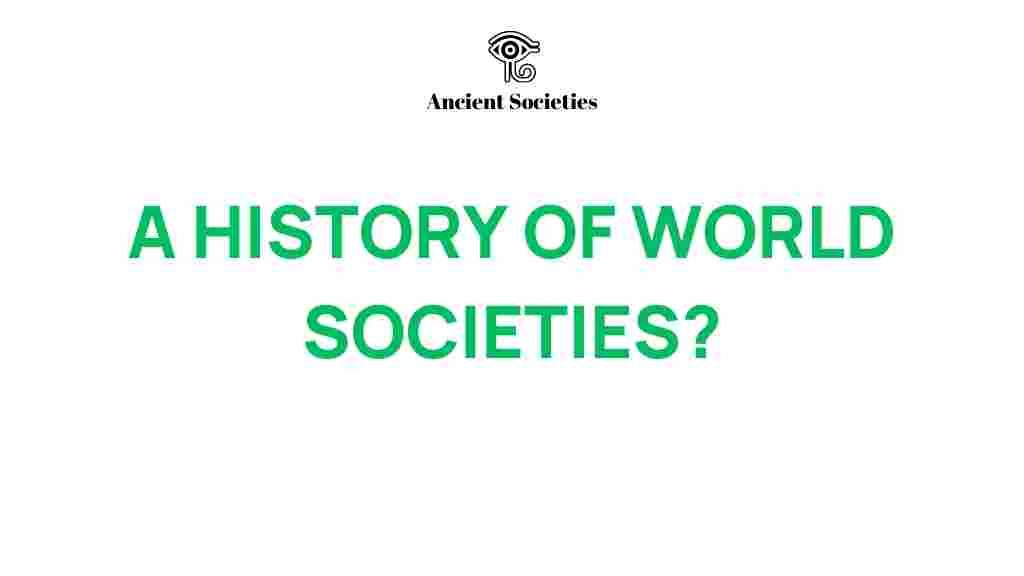Unveiling the Tapestry of World Societies
The intricate tapestry of world societies reflects the rich and diverse history of human civilization. From the ancient settlements of Mesopotamia to the bustling cities of the modern era, each culture and civilization has contributed to the social dynamics that shape our world today. This article will take you on a journey through time, exploring the historical evolution of societies, their unique cultures, and their connections across the globe. We will delve into the field of anthropology to better understand how these elements intertwine, creating the vibrant heritage we inherit today.
The Foundations of World Societies
To appreciate the evolution of world societies, we must first examine the foundations upon which they are built. These foundations can be categorized into several key areas:
- Geography: The physical landscape has influenced how societies develop, from agricultural practices to trade routes.
- Economics: The mode of production and distribution of resources shapes social structures and economic systems.
- Politics: Governance and power dynamics dictate societal organization and conflict resolution.
- Culture: Shared beliefs, values, and practices unite members of a society and distinguish them from others.
Historical Evolution of Civilizations
Throughout history, various civilizations have risen and fallen, leaving behind a legacy that informs our current understanding of world societies. Here are some pivotal moments and civilizations that played significant roles in this historical evolution:
- Mesopotamia: Often referred to as the “cradle of civilization,” ancient Mesopotamia introduced writing, law, and urbanization.
- Ancient Egypt: The Egyptians’ advances in architecture and governance set a standard for later societies.
- The Indus Valley Civilization: Known for its urban planning and advanced drainage systems, this society demonstrated early engineering prowess.
- Ancient Greece: The birthplace of democracy, philosophy, and the arts, Greece profoundly influenced Western culture.
- The Roman Empire: A model of governance, law, and infrastructure that shaped the future of Europe and beyond.
Cultural Diversity and Social Dynamics
As we explore the intricate details of world societies, it becomes evident that cultural diversity is a hallmark of human identity. Each culture contributes unique elements to social dynamics, including:
- Language: The primary means of communication, language shapes thought and cultural identity.
- Religion: Spiritual beliefs often dictate moral values and social norms within societies.
- Traditions: Customs and rituals passed down through generations foster community and continuity.
- Art and Literature: Creative expression reflects societal values and can inspire change.
Global Connections and Heritage
The interconnectedness of world societies has dramatically increased in the modern era. Globalization has facilitated the exchange of ideas, goods, and cultures, leading to a richer human experience. Here are some key aspects of these global connections:
- Cultural Exchange: The sharing of cultural practices enhances mutual understanding and respect among societies.
- Trade and Economics: Economic relationships foster interdependence and influence societal development.
- Migration: The movement of people introduces new cultural elements, enriching societies.
- Technology: Advancements in communication and transportation have shrunk the world, allowing for instant connections.
For further insight into how global connections shape our understanding of heritage, visit this comprehensive resource.
Step-by-Step Process: Understanding Societal Changes
To grasp how world societies evolve, we can follow a systematic approach:
- Identify the Society: Begin with a specific society or culture to examine its unique characteristics.
- Explore Historical Context: Investigate the historical events that shaped this society, including wars, migrations, and trade.
- Analyze Cultural Practices: Look at the traditions, languages, and religions that define the society.
- Assess Social Dynamics: Evaluate how power structures, economics, and community relationships influence societal behavior.
- Consider Global Influences: Reflect on how outside forces, such as globalization and technology, impact the society.
When studying or interacting with different world societies, it is crucial to navigate cultural sensitivities effectively. Here are some tips to avoid misunderstandings:
- Educate Yourself: Learn about the culture, history, and social norms of the society you are engaging with.
- Be Respectful: Approach cultural practices with an open mind and respect for their significance.
- Listen Actively: Engage in conversations with a willingness to listen and understand different perspectives.
- Ask Questions: If unsure about a cultural practice, ask respectfully for clarification.
- Reflect on Your Biases: Acknowledge your own cultural biases and strive to overcome them.
Conclusion: The Ongoing Journey of World Societies
The journey through world societies is an ongoing exploration of our shared human experience. As we uncover the complexities of history, culture, and social dynamics, we gain invaluable insights into our past and present. Understanding the historical evolution of civilizations, recognizing the importance of cultural diversity, and appreciating global connections enrich our lives and foster a sense of unity among humanity.
As we continue to navigate the ever-evolving landscape of world societies, let us celebrate our heritage and embrace the tapestry of cultures that define our existence. For more information on anthropology and its impact on understanding societies, check out this insightful article.
This article is in the category History and created by AncientSocieties Team
